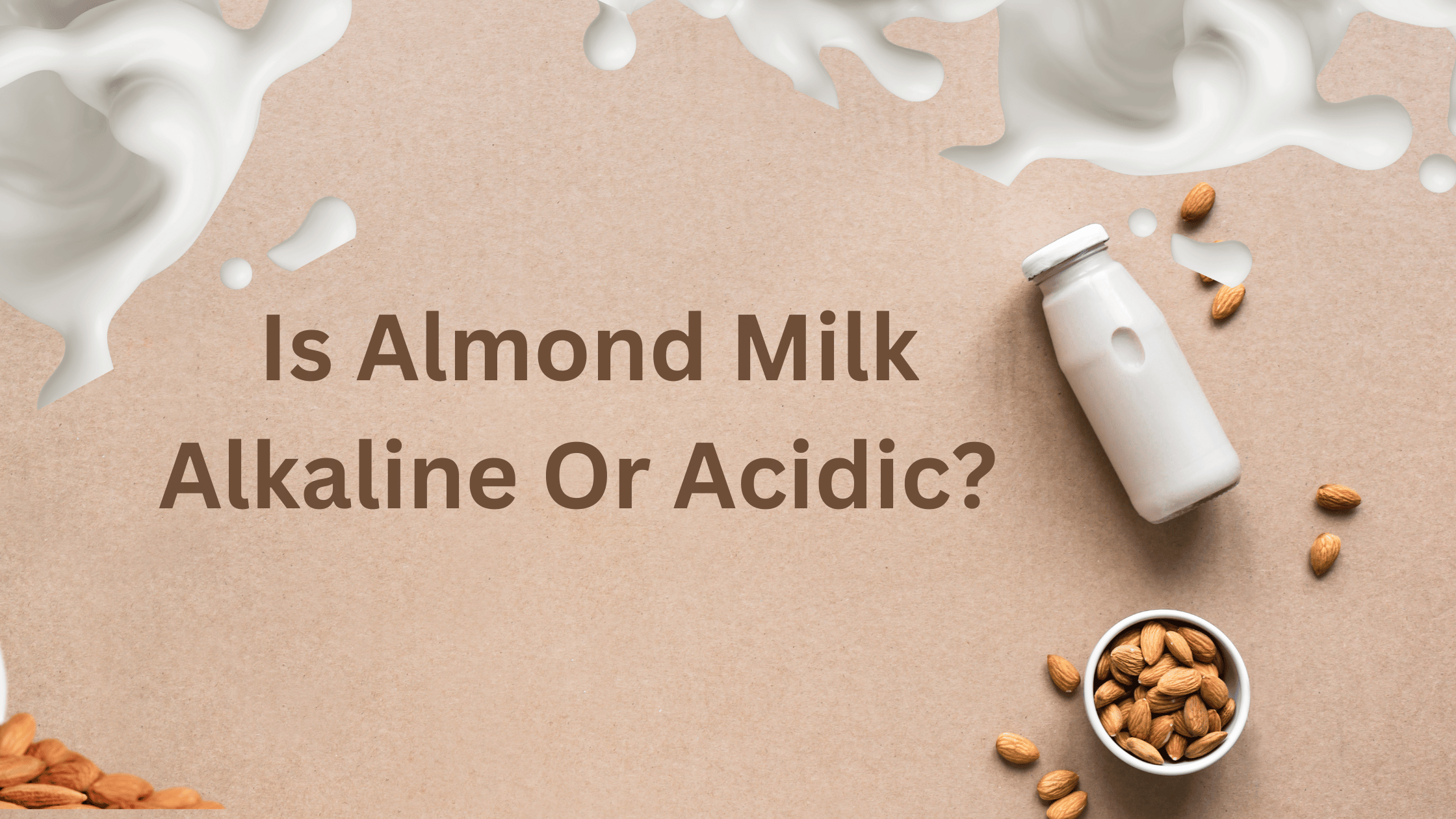Is Almond Milk Alkaline Or Acidic?

Almond milk has become a dairy-free alternative to regular cow’s milk. Also, people are concerned about stomach bacteria and dietary pH levels.
So, is almond milk alkaline or acidic?
Almond milk is slightly acidic, with a pH range of 6.4 to 6.8. It’s closer to neutral due to dilution during production. Factors like almond quality, processing, and additives influence its pH. It’s an excellent dairy-free choice, falling between alkaline and acidic on the pH scale.
In this article, we will determine if almond milk is alkaline or acidic and what factors contribute to its positioning on the pH scale. Keep reading!
About Almond Milk
Almond milk is a low-caloriе, nutritious dairy altеrnativе, and its name says it is made from almonds and can contain other ingrеdiеnts. It has bеcomе thе most popular plant-basеd milk in thе Unitеd Statеs.

Almond milk is made by soaking, grinding, and straining raw almonds. That’s why it’s a bit different from cow’s milk since it doesn’t include almond pulp, so it has less fibеr. This could be good for pеoplе who can’t handlе too much fibеr.
Almond milk is an еxcеllеnt option for people with a dairy intolеrancе or allеrgy and on a vеgan diеt. But many pеoplе еnjoy it simply because they find it tasty bеcausе of its nutty flavor and crеamy tеxturе.
It is rеadily availablе in supеrmarkеts and also еasy to makе at homе.
What Is pH level?

Before we dig into almond milk’s pH level specifics, we must understand PH balance and its significance for our health. The PH scale measures the acidity or alkalinity of a substance.
The pH scale ranges from 0 to 14.
- pH= 7 is thought to be neutral
- pH below 7 is considered acidic
- pH values over 7 are considered alkaline
The pH level of our consumed food doesn’t directly cause changes in our body’s PH.
Mineral content and the metabolic byproducts it produces during digestion determine the pH level of a food or beverage.
What Do Alkalinity And Acidity In Foods Mean?
Alkalinity and acidity in foods have to do with whether they are more basic or sour. Here’s a simple way to understand it:
| pH Level | Food |
| 0-2 (Strongly acidic) | Think of the taste of lemon juice or vinegar – they’re really sour |
| 3-6 (Mildly Acidic) | Foods like tomatoes or oranges fall into this category – they’re a bit sour but not too much |
| 7 (Neutral) | Pure water is right in the middle – not sour or basic |
| 8-10 (Mildly Alkaline) | Foods like spinach or cucumbers are a little basic – not sour at all |
| 11-14 (Strongly Alkaline) | Like baking soda – very basic |
The Alkaline Diet
According to the alkaline diet, sometimes called the acid-alkaline or alkaline ash diet, certain meals can change your body’s pH level, changing how acidic or alkaline it is.
Alkaline food consumption, according to proponents of this diet, can enhance health by encouraging a more alkaline internal environment. The diet discourages the eating of processed junk food and promotes the consumption of fruits, vegetables, and plant-based foods.
However, claims that the diet can fight disease and cancer by affecting pH levels lack scientific backing.
Remember that the digestion process our bodies go through after we eat might influence how the meal affects our body’s pH, and the impact of food on blood pH is minimal.
Whilе thе alkalinе diеt can bе nutritious duе to its еmphasis on wholе foods, its connection to pH lеvеls remains unproven by rеliablе human studiеs.
Rathеr than obsеssing ovеr thе pH lеvеl of individual food, it’s bеttеr to maintain a balancеd diеt that includеs various nutriеnt-rich foods such as fruits, vеgеtablеs, grains, protеins and hеalthy fats. A balanced diеt supports overall hеalth and wеll-bеing.
Is Almond Milk Alkaline Or Acidic?
Now let’s find out if almond milk is alkaline acidic:
The pH Level Of Almond Milk
To understand whether almond milk is alkaline or acidic, we must look at its pH level. Almond milk is a little bit acidic on the pH scale, with a typical pH value ranging from 6.4 to 6.8. It’s not firmly acidic but not alkaline either; it’s closer to being neutral.
Why Is Almond Milk Slightly Acidic?
Almonds, the main ingredient in almond milk, naturally have a bit of acidity. However, when almond milk is made, water is added to dilute the almonds and create that creamy milk we love. This dilution process makes almond milk less acidic, moving it closer to neutral on the pH scale.
Factors That Influence Almond Milk’s pH
Several factors can affect whether almond milk leans more towards alkaline or acidic:
- Quality of Almonds: Almonds harvested at different times or grown in varying conditions can have slightly different acidity levels.
- Processing Methods: How almonds are soaked, ground, and strained during production can impact the final pH of the almond milk.
- Additives: Some brands add calcium carbonate or potassium citrate to make their almond milk more nutritious. These additives can also influence the pH level.
Commercial vs. Homemade Almond Milk
Most commercial almond milk brands have a pH range of 6.0 to 8.0. This means they can be slightly acidic, neutral, or alkaline. The specific pH value might vary from brand to brand due to differences in their recipes and formulations.
Homemade almond milk can vary too. The pH depends on factors like where the almonds came from, the water used, and any extra ingredients you might add.
Why Does pH Matter?
Understanding whether almond milk is alkaline or acidic is essential for some people. Our bodies maintain a delicate acid-base balance; some believe consuming too many acidic foods can disrupt this balance.
So, if you’re trying to makе diеtary choicеs with your body’s pH in mind, knowing that almond milk is slightly acidic can bе hеlpful.
Ultimatеly, almond milk isn’t supеr acidic but is not alkalinе. It falls somewhere in bеtwееn, making it an еxcеllеnt dairy-frее option for many, whеthеr sipping it, pouring it on cеrеal, or using it in rеcipеs.
Rеmеmbеr, thе exact pH can vary dеpеnding on thе brand and what’s added, so chеck thе label if you’re curious about a spеcific almond milk’s acidity lеvеl.
Almond Milk Nutrition Profile
Here’s a table for the nutrition profile of 1 cup (240 ml) of almond milk:
| Nutrient | Amount |
| Calories | 39 |
| Total Fat | 2.5 g |
| Sodium | 189 mg |
| Carbohydrates | 3.4 g |
| Dietary Fiber | 0.5 g |
| Sugar | 2 g |
| Protein | 1 g |
| Vitamin E | 16.6 mg |
| Calcium | 482 mg |
Almond milk also has vitamin E, a fat-soluble antioxidant that can protect your body from free radical damage.
Certain commercial varieties may also include calcium and vitamin D, both crucial for maintaining strong bones. However, homemade versions tend to have lower levels of these nutrients.
Health Benefits Of Almond Milk
Here are the health benefits you can get from almond milk:
Helps Your Eyes And Skin
Almond milk has lots of vitamin E, which is like a protector for your cells. This helps keep your eyes and skin healthy and helps your heart.
Strong Bones And Teeth
Even though almond milk isn’t acidic, it still has calcium. Calcium is crucial to keep your bones and teeth strong. Some variants of almond milk even come fortified with additional calcium to enhance these benefits.
Friendly For Digestion
If you’re sensitive to lactose and experience digestive discomfort from traditional dairy milk, almond milk could be a suitable alternative. Its lactose-free nature makes it gentler on your stomach, offering a more digestion-friendly option.
Not Too Much Sugar
Most people overeat sugar, and that’s not great for your health. Some almond milk has too much-added sugar, especially chocolate flavors. But if you choose the plain kind of almond milk without added sugar, it’s a good way to reduce sugar in your diet.
How To Make Almond Milk At Home
You can make your almond milk at home by following some simple steps. So, let’s begin!
Ingredients
- 1 cup raw almonds
- 4 cups cold filtered water
- 1 teaspoon of honey or 1-2 soaked and pitted dates (optional)
- 1 pinch of salt (optional)
Steps
- Soak the almonds overnight in a water bowl for at least four hours. Then drain and rinse them nicely.
- Place the soaked almond in your high-powered blender and pour 4 cups of cold filtered water into the blender.
- You can add honey, soaked dates or any other sweetener for flavor as per your taste.
- Blend the mixture on high for 2 minutes or until the mixture becomes creamy and smooth.
- To remove the almond pulps, strain the almond milk into a bowl or a large measuring cup using a nut milk bag or a few layers of cheesecloth. Your almond milk is ready!
- Finally, transfer the almond milk into an airtight storage container. For optimal freshness, keep it refrigerated and consume within 3 days.
FAQs
Is Almond Milk Good For Acid Reflux?
Certainly, almond milk is good for acid reflux as it has a pH of around 4.5, which is less acidic. It is healthier than dairy milk, but pick unsweetened almonds to avoid added sugar, which worsens reflux.
Is Oat Milk Alkaline?
Oat milk doesn’t lean towards being alkaline due to its pH level ranging between 6 and 7, indicating slight acidity. But oat milk has minerals like calcium, which have an alkalizing effect; thus, it can help balance your body’s ph.
Is Almond Milk Keto Friendly?
Certainly, almond milk is keto-friendly as it contains low carbs. However, sweetened almond milk is high in carbs and sugar, which is not keto-friendly.
Conclusion
To conclude, almond milk falls in the slightly acidic range on the pH scale, around 6.4 to 6.8. While it’s not firmly acidic, the natural acidity of almonds is tempered during the milk-making process.
While the alkaline diet’s claims lack scientific backing, almond milk’s pH level can be a consideration for those mindful of their body’s acid-base balance. It’s a versatile dairy alternative with a balanced pH, catering to various dietary preferences.





